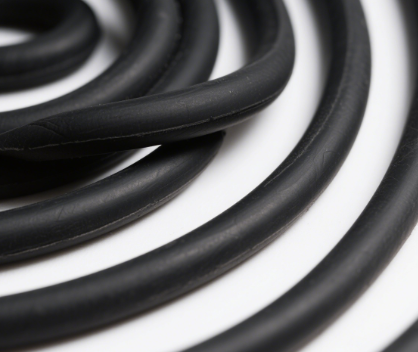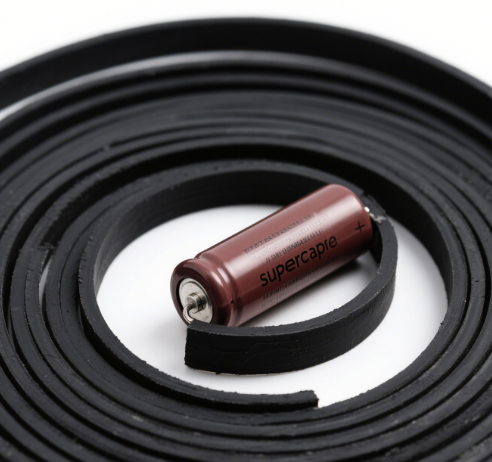carbon nanotube conductive rubber
Carbon nanotube conductive rubber is a multifunctional composite material formed by uniformly dispersing carbon nanotubes (CNTs) in a rubber matrix. It combines the high elasticity of rubber and the excellent electrical conductivity of carbon nanotubes, showing broad application prospects in fields such as flexible electronics, medical devices, and the automotive industry. The following is a detailed analysis from aspects such as material properties, preparation techniques, performance optimization, and application scenarios:
- Material Properties and Conductive Mechanism
The Unique Advantages of Carbon Nanotubes
Carbon nanotubes have a high aspect ratio (up to 1000:1), high electrical conductivity (theoretical value of 10^6 S/m), and high strength (tensile strength of 100 GPa), and can form a three-dimensional conductive network in the rubber matrix. Their excellent mechanical properties can significantly improve the fatigue resistance and wear resistance of rubber. For example, adding carbon nanotubes to tires can reduce the rolling resistance by 15% and shorten the braking distance by 10%.
Conductive Mechanism
Carbon nanotubes achieve conductivity in rubber through the percolation effect: when the content of CNTs exceeds the critical percolation threshold (usually 0.1%-2%), they come into contact with each other to form a continuous conductive path. In addition, the tunneling effect also contributes to part of the conductivity, that is, electrons are transmitted between adjacent CNTs through the quantum tunneling effect. For example, after adding a 4% carbon nanotube dispersion to butyl rubber, the alternating current conductivity can reach 0.061 S/m.
- Preparation Techniques and Key Challenges
Mainstream Preparation Methods
Solution Mixing Method: Disperse CNTs in an organic solvent and mix them with a rubber solution, and then evaporate the solvent. For example, the team from Changzhou University designed a “egg roll structure”, winding the CNT film around a rubber core to achieve a superelastic conductor with unchanged resistance when stretched 14 times.
Melt Blending Method: Mix CNTs and the rubber matrix in a twin-screw extruder at high temperature. The X technology patent combines ultrasonic dispersion with open mill mixing to solve the agglomeration problem of CNTs, enabling CNTs to form a uniform three-dimensional network in the rubber.
In-situ Polymerization Method: Introduce CNTs during the polymerization process of rubber monomers to achieve nanoscale dispersion. For example, the team from Qingdao University of Science and Technology prepared CNT/MXene composite filler through electrostatic self-assembly, forming an efficient conductive network in butyl rubber, and the sensitivity of the sensor reached 35137 GF.
Core Technical Difficulties
Dispersion Optimization: CNTs are prone to agglomeration due to van der Waals forces and need to be improved through surface modification (such as selenolation treatment) or the assistance of a dispersant (such as OP-10 emulsifier).
Interface Bonding: The interfacial interaction between CNTs and the rubber matrix is weak, and it can be enhanced through chemical grafting (such as introducing selenol groups) or a dual-network design (coordination between the cross-linking network and the conductive network).
III. Performance Breakthroughs and Application Scenarios
Key Performance Improvements
Electrical Performance: Adding only 0.06 wt% of CNTs can make the electrical conductivity of silicone rubber break through the percolation threshold, and the resistance change is less than 10 times when stretched by 520%.
Mechanical Performance: After adding TUBALL™ single-walled carbon nanotubes to fluororubber, the tensile strength is increased by 20%, and the mechanical stability after thermal aging is increased by 50%.
Environmental Adaptability: The MXene/CNT composite rubber still maintains stable conductivity at a low temperature of -60°C, which is suitable for energy storage devices in polar environments.
Typical Application Fields
Flexible Electronics: Stretchable sensors (such as human motion monitoring), artificial muscles (the energy storage capacity of capacitive sensors is increased by 10 times).
Medical Devices: Conductive bodies for pacemakers, wearable health monitoring devices (such as flexible electrodes that conform to human tissues).
Automotive Industry: Antistatic tires (the electrostatic discharge efficiency is increased by 30%), conductive seals (the resistance to fuel aging is enhanced).
Energy Field: Conductive additives for lithium batteries (the cycle life of silicon-based anodes is extended by 50%), flexible solar cell electrodes.
- Commercialization Progress and Challenges
Industry Trends
Technical Breakthroughs: The patent for “carbon nanotube modified conductive fluororubber” approved by Xiamen Huatan Technology in 2025, through the coordination of metal oxides and CNTs, reduces the surface resistivity of fluororubber to below 10^7 Ω/sq.
Product Cases: The CNT conductive masterbatch of Jiangsu Tiannai Technology has been applied to tires and lithium batteries, and adding only 1/10 of the amount of carbon black can achieve the same conductive effect.
Existing Challenges
Cost Issues: The production cost of CNTs is relatively high, accounting for more than 70% of the total material cost. It is necessary to reduce costs through large-scale production (such as OCSiAl’s TUBALL™ MATRIX predispersion) and process optimization.
Environmental Risks: The biocompatibility of CNTs still needs to be verified, and it is necessary to reduce toxicity through surface functionalization (such as PEG modification).
- Future Development Directions
Material Design
Multi-scale Composite: CNTs collaborate with two-dimensional materials such as graphene and MXene to construct a three-dimensional conductive network (for example, the electrical conductivity of MXene/CNT composite fibers reaches 10^4 S/m).
Intelligent Response: Develop temperature-sensitive and pressure-sensitive conductive rubber for self-healing electronic devices.
Process Innovation
3D Printing: Realize customized manufacturing of conductive rubber with complex structures (such as the low-temperature energy storage electrode of Huazhong University of Science and Technology).
Green Preparation: Adopt environmentally friendly processes such as water-based dispersion and supercritical fluid treatment to reduce solvent pollution.
Carbon nanotube conductive rubber is moving from the laboratory to industrialization, and its applications in fields such as flexible electronics and medical health will promote the development of a new generation of intelligent materials. With continuous breakthroughs in dispersion technology and interface engineering, this material is expected to replace traditional conductive materials in more fields and become a key support for “Industry 4.0” and “Made in China 2025”.
















